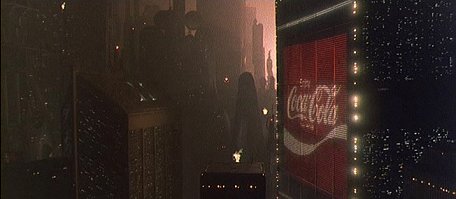The other night I fell asleep watching Blade Runner.
Before nodding off I got to see a young Edward James Olmos (a nice juxtaposition to seeing him in Battlestar Galactica) and the amazing logo laden neon skylines that serve as the back drop to the epic Philip K. Dick story.

A lot has been made of the product placement used in Blade Runner. Not because it was the first to use it, or that it was so prominent (which it was) but because many of the advertisers fell on hard times.
Among the folklore that has grown up around the film over the years has been the belief that the film was a curse to the companies whose logos were displayed prominently as product placements in some scenes. While they were market leaders at the time, many of them experienced disastrous setbacks over the next decade and hardly exist today. [Wikipedia]
The blatant product placement, track record of the advertisers and new technology got me thinking. What happens when an advertiser or brand ceases to exist? Right now that brand will live forever on film, locked on celluloid for eternity. But does it have to be that way?
Could product replacement be a new advertising venue?
In the digital age the logo of Coca-Cola can be swapped with that of Pepsi. Atari could be replaced by Wii. A dead brand can be replaced by the new thriving brand. Science Fiction has the greatest ability to make these changes because there are no inherent problems with anachronisms.
Period pieces would probably be off-limits (e.g. – Sense and Sensibility) and modern movies would pose potential, but not unsolvable, problems. For instance, the Mellow Yellow car featured in Days of Thunder couldn’t be digitally altered to promote ROCKST★R but could to promote Mountain Dew.
It’s an intriguing idea, though I’m sure some movie purists would howl at the moon if product replacement came to fruition. Yet, the new formats in which we’re consuming media make this type of substitution seem possible.
Product placement localization seems likely too. Imagine a character drinking from a branded bottle of beer. Couldn’t that brand be altered based on localization? Bud Light in the United States, Labatt Blue in Canada, Skol in Brazil and Krombacher in Germany.
Clearly this wouldn’t always make sense and could disrupt the suspension of disbelief necessary for many films. Make no mistake, product replacement is a Pandora’s box. But imagine the additional revenue potential of selling ‘dead brand’ space in movies.
Would you be disturbed by product replacement?
The Next Post: Call To Action Button Size and Color
The Previous Post: Post Click SEO

Comments Down Here
// I Accept Wit, Insight, Disagreement, and American Express.
Sorry, comments for this entry are closed at this time.
You can follow any responses to this entry via its RSS comments feed.